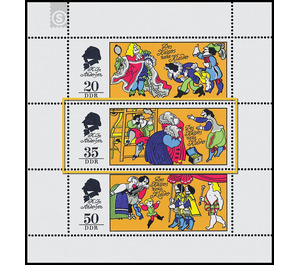Commemorative stamp series - Germany / German Democratic Republic 1975 - 35 Pfennig
Theme: Mythology
| Country | Germany / German Democratic Republic |
| Issue Date | 1975 |
| Face Value | 35.00 |
| Color | multi-colored brown |
| Perforation | K 14:13 |
| Printing Type | offset |
| Stamp Type | Postage stamp |
| Item Type | Stamp |
| Chronological Issue Number | 1839 |
| Chronological Chapter | GER-DDR |
| SID | 849755 |
| In 16 Wishlists | |
Märchen-Kleinbogen, issue 1975 The Ministry of Posts and Telecommunications of the German Democratic Republic publishes three multicolored special postage stamps with motifs from the fairy tale "The Emperor's New Clothes" by the Danish poet Hans Christian Andersen. The three stamps are printed on a sheetlet. No special first-day cover envelope The Emperor's New Clothes This year commemorates the world of the 100th anniversary of the death of the great Danish poet Hans Christian Andersen (1805-1875). We owe more than 150 fairytales to him. One of his finest is "The Emperor's New Clothes", which he published in the third issue of his "Fairy Tales for Children" in 1837. Andersen had found the literary model for this fairy tale in the novella collection "EI conde Lucano" by Spaniard Juan Manuel (1282 to 1349), which had been translated by Joseph von Eichendorff. In the novella "Of the three swindlers," the king is promised a carpet that he can not see who is not the son of his supposed father. Andersen changed the novella and understood how to wrap his criticism of the court's pomp, the servility and hypocrisy of state officials into a fairytale form. The most important episodes of the fairy tale are arranged in the stamp series as follows: An emperor, who was only intent on beautiful clothes and spent all his money, two fraudsters turn out to be weavers. They declare that they knew how to weave the most beautiful things, and that the garments sewn from them would remain invisible to anyone who was unworthy of his office or unforgivably stupid. The Emperor, who sees a convenient way to simultaneously check the officials of his empire, gives the swindlers an order (20-pfennig value). The scammers pretend that they are weaving and demand precious ingredients. The Emperor soon becomes curious, and, as a precaution, sends his old minister, and soon afterwards another worthy statesman to visit. The scammers point to the empty loom and describe the patterns and colors of the stuff that is not there. But no one dares to say that he sees nothing; each repeats only the descriptions of the fraudsters (35-pfennig value). Even the emperor does not admit that he sees nothing, but rewards the fraudsters and distinguishes them. On the advice of his followers, he gets the swindlers to make clothes from the supposed stuff to carry them to the procession. When the Emperor walks through the city in these "new clothes," no one dares to say that he sees no new clothes until a child calls, he has nothing (50-pfennig value).


